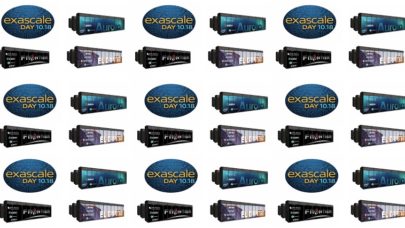
US Pursues Next-gen Exascale Systems with 5-10x the Performance of Frontier
June 28, 2022
With the Linpack exaflops milestone achieved by the Frontier supercomputer at Oak Ridge National Laboratory, the United States is turning its attention to the next crop of exascale machines, some 5-10x more performant than Frontier. At least one such system is being planned for the 2025-2030 timeline, and the DOE is soliciting input from the vendor community... Read more…

ANL Special Colloquium on The Future of Computing
May 19, 2022
There are, of course, a myriad of ideas regarding computing’s future. At yesterday’s Argonne National Laboratory’s Director’s Special Colloquium, The Future of Computing, guest speaker Sadasivan Shankar, did his best to convince the audience that the high-energy cost of the current computing paradigm – not (just) economic cost; we’re talking entropy here – is fundamentally undermining computing’s progress such that... Read more…

Argonne Supercomputer Advances Energy Storage Research
May 13, 2022
The lack of large-scale energy storage bottlenecks many sources of renewable energy, such as sunlight-reliant solar power and unpredictable wind power. Researchers from Lawrence Livermore National Laboratory (LLNL) are working on changing that, leveraging an allocation on Argonne National Laboratory’s Theta supercomputer to better understand the dynamics of ion transport that are at the core... Read more…

Exascale Watch: Aurora Installation Underway, Now Open for Reservations
May 10, 2022
Installation has begun on the Aurora supercomputer, Rick Stevens (associate director of Argonne National Laboratory) revealed today during the Intel Vision event keynote taking place in Dallas, Texas, and online. Joining Intel exec Raja Koduri on stage, Stevens confirmed that the Aurora build is underway – a major development for a system that is projected to deliver more... Read more…

Aurora’s Troubles Move Frontier into Pole Exascale Position
October 1, 2020
Intel’s 7nm node delay has raised questions about the status of the Aurora supercomputer that was scheduled to be stood up at Argonne National Laboratory next year. Aurora was in the running to be the United States’ first exascale supercomputer although it was on a contemporaneous timeline with... Read more…

First Annual Exascale Day Celebrates Next 1000x Horizon
October 21, 2019
October 18 (aka 10/18) marked the first annual exascale day, hosted by Cray, the Exascale Computing Project and the DOE labs -- Argonne, Oak Ridge and Lawrence Read more…

Cerebras to Supply DOE with Wafer-Scale AI Supercomputing Technology
September 17, 2019
Cerebras Systems, which debuted its wafer-scale AI silicon at Hot Chips last month, has entered into a multi-year partnership with Argonne National Laboratory and Lawrence Livermore National Laboratory as part of a larger collaboration with the U.S. Department of Energy... Read more…

Argonne Team Tackles Uncertainties in Engine Simulation
August 27, 2015
As we head deeper into the digital age, computers appropriate an ever greater share of the work of designing and testing physical systems, spanning the gamu Read more…

- Click Here for More Headlines

Whitepaper
Transforming Industrial and Automotive Manufacturing
In this era, expansion in digital infrastructure capacity is inevitable. Parallel to this, climate change consciousness is also rising, making sustainability a mandatory part of the organization’s functioning. As computing workloads such as AI and HPC continue to surge, so does the energy consumption, posing environmental woes. IT departments within organizations have a crucial role in combating this challenge. They can significantly drive sustainable practices by influencing newer technologies and process adoption that aid in mitigating the effects of climate change.
While buying more sustainable IT solutions is an option, partnering with IT solutions providers, such and Lenovo and Intel, who are committed to sustainability and aiding customers in executing sustainability strategies is likely to be more impactful.
Learn how Lenovo and Intel, through their partnership, are strongly positioned to address this need with their innovations driving energy efficiency and environmental stewardship.
Download Now
Sponsored by Lenovo
Whitepaper
How Direct Liquid Cooling Improves Data Center Energy Efficiency
Data centers are experiencing increasing power consumption, space constraints and cooling demands due to the unprecedented computing power required by today’s chips and servers. HVAC cooling systems consume approximately 40% of a data center’s electricity. These systems traditionally use air conditioning, air handling and fans to cool the data center facility and IT equipment, ultimately resulting in high energy consumption and high carbon emissions. Data centers are moving to direct liquid cooled (DLC) systems to improve cooling efficiency thus lowering their PUE, operating expenses (OPEX) and carbon footprint.
This paper describes how CoolIT Systems (CoolIT) meets the need for improved energy efficiency in data centers and includes case studies that show how CoolIT’s DLC solutions improve energy efficiency, increase rack density, lower OPEX, and enable sustainability programs. CoolIT is the global market and innovation leader in scalable DLC solutions for the world’s most demanding computing environments. CoolIT’s end-to-end solutions meet the rising demand in cooling and the rising demand for energy efficiency.
Download Now
Sponsored by CoolIT
Advanced Scale Career Development & Workforce Enhancement Center
Featured Advanced Scale Jobs:
HPCwire Resource Library
HPCwire Product Showcase
© 2024 HPCwire. All Rights Reserved. A Tabor Communications Publication
HPCwire is a registered trademark of Tabor Communications, Inc. Use of this site is governed by our Terms of Use and Privacy Policy.
Reproduction in whole or in part in any form or medium without express written permission of Tabor Communications, Inc. is prohibited.
























